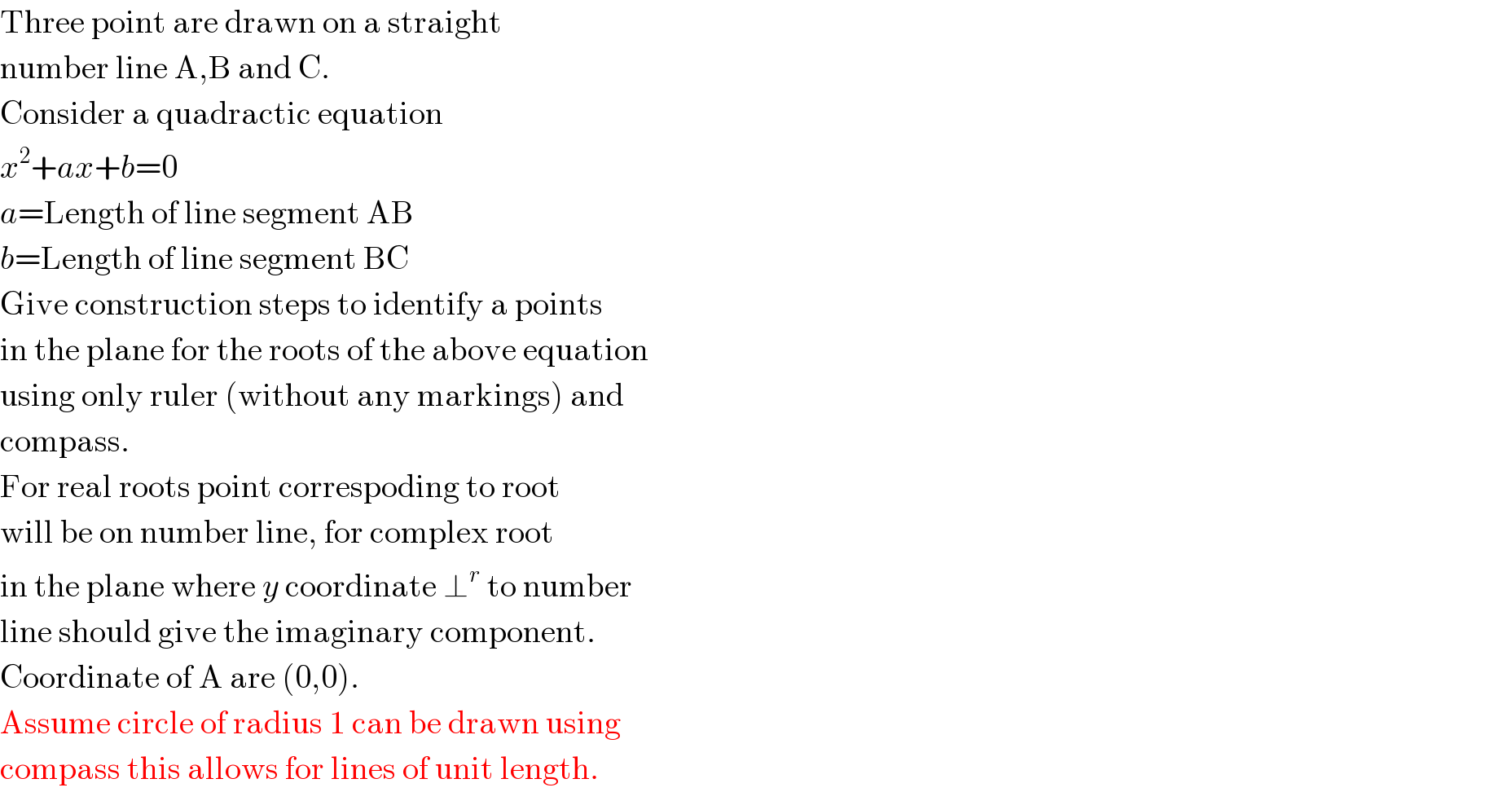
Question Number 3588 by prakash jain last updated on 16/Dec/15

$$\mathrm{Three}\:\mathrm{point}\:\mathrm{are}\:\mathrm{drawn}\:\mathrm{on}\:\mathrm{a}\:\mathrm{straight} \\ $$$$\mathrm{number}\:\mathrm{line}\:\mathrm{A},\mathrm{B}\:\mathrm{and}\:\mathrm{C}. \\ $$$$\mathrm{Consider}\:\mathrm{a}\:\mathrm{quadractic}\:\mathrm{equation} \\ $$$${x}^{\mathrm{2}} +{ax}+{b}=\mathrm{0} \\ $$$${a}=\mathrm{Length}\:\mathrm{of}\:\mathrm{line}\:\mathrm{segment}\:\mathrm{AB} \\ $$$${b}=\mathrm{Length}\:\mathrm{of}\:\mathrm{line}\:\mathrm{segment}\:\mathrm{BC} \\ $$$$\mathrm{Give}\:\mathrm{construction}\:\mathrm{steps}\:\mathrm{to}\:\mathrm{identify}\:\mathrm{a}\:\mathrm{points} \\ $$$$\mathrm{in}\:\mathrm{the}\:\mathrm{plane}\:\mathrm{for}\:\mathrm{the}\:\mathrm{roots}\:\mathrm{of}\:\mathrm{the}\:\mathrm{above}\:\mathrm{equation} \\ $$$$\mathrm{using}\:\mathrm{only}\:\mathrm{ruler}\:\left(\mathrm{without}\:\mathrm{any}\:\mathrm{markings}\right)\:\mathrm{and} \\ $$$$\mathrm{compass}. \\ $$$$\mathrm{For}\:\mathrm{real}\:\mathrm{roots}\:\mathrm{point}\:\mathrm{correspoding}\:\mathrm{to}\:\mathrm{root} \\ $$$$\mathrm{will}\:\mathrm{be}\:\mathrm{on}\:\mathrm{number}\:\mathrm{line},\:\mathrm{for}\:\mathrm{complex}\:\mathrm{root} \\ $$$$\mathrm{in}\:\mathrm{the}\:\mathrm{plane}\:\mathrm{where}\:{y}\:\mathrm{coordinate}\:\bot^{{r}} \:\mathrm{to}\:\mathrm{number} \\ $$$$\mathrm{line}\:\mathrm{should}\:\mathrm{give}\:\mathrm{the}\:\mathrm{imaginary}\:\mathrm{component}. \\ $$$$\mathrm{Coordinate}\:\mathrm{of}\:\mathrm{A}\:\mathrm{are}\:\left(\mathrm{0},\mathrm{0}\right). \\ $$$$\mathrm{Assume}\:\mathrm{circle}\:\mathrm{of}\:\mathrm{radius}\:\mathrm{1}\:\mathrm{can}\:\mathrm{be}\:\mathrm{drawn}\:\mathrm{using} \\ $$$$\mathrm{compass}\:\mathrm{this}\:\mathrm{allows}\:\mathrm{for}\:\mathrm{lines}\:\mathrm{of}\:\mathrm{unit}\:\mathrm{length}. \\ $$
Answered by Rasheed Soomro last updated on 19/Dec/15

$$\mid\underset{\overset{} {−}} {\overline {\boldsymbol{\mathcal{A}}\:\:\boldsymbol{\mathcal{TRY}}\:}}\mid \\ $$$${x}=\frac{−{a}\pm\sqrt{{a}^{\mathrm{2}} −\mathrm{4}{b}}}{\mathrm{2}} \\ $$$${For}\:{real}\:{roots}\:: \\ $$$${a},{b}\:{are}\:{given}.\:{a}\:{line}\:{segment}\:{of}\:{length}\:{a}^{\mathrm{2}} \:{can}\:{be}\: \\ $$$${acheived}\:{in}\:{light}\:{of}\:{your}\:{answer}\:{of}\:{Q}\:\mathrm{3607}. \\ $$$${subtracting}\:{four}\:{times}\:{b}.{Square}\:{root}\:{is}\:{achieveable}. \\ $$$${subtracting}\:\:{a}..{halve}\:{the}\:{line}\:{segment}... \\ $$$${I},{ll}\:{write}\:{answe}\:{in}\:{detail}\:{at}\:{present}\:{only}\:{for} \\ $$$${real}\:{x}.... \\ $$$${Assuming}\:{a},{b}>\mathrm{0}\:\left[{a}\:,\:{b}\:{are}\:{on}\:{right}\:{sides}\:{of}\:{origin}.\right. \\ $$$${A}=\left(\mathrm{0},\mathrm{0}\right)\:\left({given}\right) \\ $$$${Coordinates}\:{of}\:{B}\:{and}\:{C}\:\:\:{along}\:\overset{\rightarrow} {{ABC}}\:\left({x}−{axis}\right)\:\:{will}\:{be} \\ $$$$\left({a},\mathrm{0}\right)\:{and}\:\left({a}+{b},\mathrm{0}\right)\:{respectively}.\left({Assuming}\right. \\ $$$$\left.{B}\:{is}\:{between}\:{A}\:{and}\:\:{C}\right) \\ $$$$\vdots \\ $$$${For}\:{complex}\:{roots}: \\ $$$${x}^{\mathrm{2}} +{ax}+{b}=\mathrm{0} \\ $$$${Let}\:\:{x}={x}_{\mathrm{1}} +{i}\:{x}_{\mathrm{2}} \\ $$$$\left({x}_{\mathrm{1}} +{i}\:{x}_{\mathrm{2}} \right)^{\mathrm{2}} +{a}\left({x}_{\mathrm{1}} +{i}\:{x}_{\mathrm{2}} \right)+{b}=\mathrm{0} \\ $$$${x}_{\mathrm{1}} ^{\mathrm{2}} −{x}_{\mathrm{2}} ^{\mathrm{2}} +\mathrm{2}{x}_{\mathrm{1}} {x}_{\mathrm{2}} {i}+{ax}_{\mathrm{1}} +{ax}_{\mathrm{2}} {i}\:+{b}=\mathrm{0}\:\:\:;\:\:{a},{b}\in\mathbb{R}^{+} \\ $$$${x}_{\mathrm{1}} ^{\mathrm{2}} −{x}_{\mathrm{2}} ^{\mathrm{2}} +{ax}_{\mathrm{1}} +{b}=\mathrm{0}\:\wedge\:\:\mathrm{2}{x}_{\mathrm{1}} {x}_{\mathrm{2}} +{ax}_{\mathrm{2}} =\mathrm{0} \\ $$$$\mathrm{2}{x}_{\mathrm{1}} {x}_{\mathrm{2}} +{ax}_{\mathrm{2}} =\mathrm{0}\Rightarrow{x}_{\mathrm{2}} \left(\mathrm{2}{x}_{\mathrm{1}} +{a}\right)=\mathrm{0}\Rightarrow{x}_{\mathrm{2}} =\mathrm{0}\:\:\vee\:\:{x}_{\mathrm{1}} =−\frac{{a}}{\mathrm{2}} \\ $$$${For}\:{x}_{\mathrm{2}} =\mathrm{0} \\ $$$${x}_{\mathrm{1}} ^{\mathrm{2}} −{x}_{\mathrm{2}} ^{\mathrm{2}} +{ax}_{\mathrm{1}} +{b}=\mathrm{0}\Rightarrow{x}_{\mathrm{1}} ^{\mathrm{2}} +{ax}_{\mathrm{1}} +{b}=\mathrm{0} \\ $$$${x}_{\mathrm{1}} =\frac{−{a}\pm\sqrt{{a}^{\mathrm{2}} −\mathrm{4}{b}}}{\mathrm{2}} \\ $$$${x}_{\mathrm{1}} +{x}_{\mathrm{2}} {i}=\frac{−{a}\pm\sqrt{{a}^{\mathrm{2}} −\mathrm{4}{b}}}{\mathrm{2}}+\mathrm{0}{i}=\frac{−{a}\pm\sqrt{{a}^{\mathrm{2}} −\mathrm{4}{b}}}{\mathrm{2}} \\ $$$$\boldsymbol{\mathrm{points}}\:\boldsymbol{\mathrm{of}}\:\boldsymbol{\mathrm{the}}\:\boldsymbol{\mathrm{roots}}\:\boldsymbol{\mathrm{are}}\:\left(\frac{−{a}\pm\sqrt{{a}^{\mathrm{2}} −\mathrm{4}{b}}}{\mathrm{2}}\:,\:\mathrm{0}\right) \\ $$$$\boldsymbol{\mathrm{we}}\:\boldsymbol{\mathrm{need}}\:\boldsymbol{\mathrm{the}}\:\boldsymbol{\mathrm{lengths}}\:\:\frac{−{a}+\sqrt{{a}^{\mathrm{2}} −\mathrm{4}{b}}}{\mathrm{2}}\:\boldsymbol{\mathrm{and}}\:\frac{−{a}−\sqrt{{a}^{\mathrm{2}} −\mathrm{4}{b}}}{\mathrm{2}} \\ $$$$\boldsymbol{\mathrm{which}}\:\boldsymbol{\mathrm{are}}\:\boldsymbol{\mathrm{clearly}}\:\boldsymbol{\mathrm{constructible}}. \\ $$$${For}\:{x}_{\mathrm{1}} =−\frac{{a}}{\mathrm{2}} \\ $$$$\left(−\frac{{a}}{\mathrm{2}}\right)^{\mathrm{2}} −{x}_{\mathrm{2}} ^{\mathrm{2}} +{a}\left(−\frac{{a}}{\mathrm{2}}\right)+{b}=\mathrm{0} \\ $$$$\frac{{a}^{\mathrm{2}} }{\mathrm{4}}−{x}_{\mathrm{2}} ^{\mathrm{2}} −\frac{{a}^{\mathrm{2}} }{\mathrm{2}}+{b}=\mathrm{0}\Rightarrow{x}_{\mathrm{2}} ^{\mathrm{2}} =\frac{{a}^{\mathrm{2}} }{\mathrm{4}}−\frac{{a}^{\mathrm{2}} }{\mathrm{2}}+{b} \\ $$$${x}_{\mathrm{2}} =\pm\sqrt{\frac{{a}^{\mathrm{2}} −\mathrm{2}{a}^{\mathrm{2}} +\mathrm{4}{b}}{\mathrm{4}}} \\ $$$${x}_{\mathrm{2}} =\pm\frac{\sqrt{−{a}^{\mathrm{2}} +\mathrm{4}{b}}}{\mathrm{2}} \\ $$$${x}_{\mathrm{1}} +{x}_{\mathrm{2}} {i}=−\:\frac{{a}}{\mathrm{2}}\pm\left(\frac{\sqrt{−{a}^{\mathrm{2}} +\mathrm{4}{b}}}{\mathrm{2}}\right){i} \\ $$$$\boldsymbol{\mathrm{Points}}\:\boldsymbol{\mathrm{are}}\:\left(−\:\frac{{a}}{\mathrm{2}}\:,\:\frac{\sqrt{−{a}^{\mathrm{2}} +\mathrm{4}{b}}}{\mathrm{2}}\right)\:\boldsymbol{\mathrm{and}}\:\left(−\:\frac{{a}}{\mathrm{2}}\:,−\:\frac{\sqrt{−{a}^{\mathrm{2}} +\mathrm{4}{b}}}{\mathrm{2}}\right) \\ $$$$\boldsymbol{\mathrm{Lengths}}\:\boldsymbol{\mathrm{needed}}\:\boldsymbol{\mathrm{are}}\:−\:\frac{{a}}{\mathrm{2}}\:\:\:\boldsymbol{\mathrm{and}}\:\frac{\sqrt{−{a}^{\mathrm{2}} +\mathrm{4}{b}}}{\mathrm{2}} \\ $$$$\boldsymbol{\mathrm{which}}\:\boldsymbol{\mathrm{are}}\:\boldsymbol{\mathrm{constructible}}. \\ $$$$\:\:\:\:\:\:\:\:\:\:\:\:\:\: \\ $$
